
Mughal painting
Encyclopedia
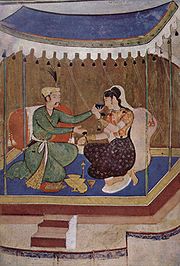
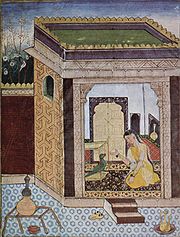
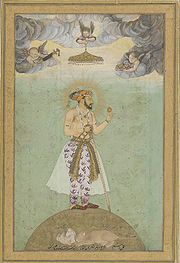
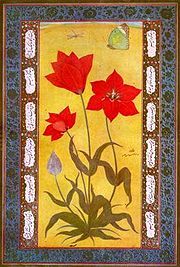
Painting
Painting is the practice of applying paint, pigment, color or other medium to a surface . The application of the medium is commonly applied to the base with a brush but other objects can be used. In art, the term painting describes both the act and the result of the action. However, painting is...
, generally confined to miniatures
Miniature (illuminated manuscript)
The word miniature, derived from the Latin minium, red lead, is a picture in an ancient or medieval illuminated manuscript; the simple decoration of the early codices having been miniated or delineated with that pigment...
either as book illustrations or as single works to be kept in albums, which emerged from Persian miniature
Persian miniature
A Persian miniature is a small painting on paper, whether a book illustration or a separate work of art intended to be kept in an album of such works called a muraqqa. The techniques are broadly comparable to the Western and Byzantine traditions of miniatures in illuminated manuscripts...
painting, with Indian Hindu, Jain, and Buddhist influences, and developed largely in the court of the Mughal Empire
Mughal Empire
The Mughal Empire , or Mogul Empire in traditional English usage, was an imperial power from the Indian Subcontinent. The Mughal emperors were descendants of the Timurids...
(16th - 19th centuries), and later spread to other Indian courts, both Muslim and Hindu, and later Sikh.
Origins
There was already a Muslim tradition of miniature painting under the Sultanate of Delhi which the Mughals overthrew. Although the first surviving manuscripts are from ManduMandu
Mandu or Mandavgad is a ruined city in the Dhar district in the Malwa region of western Madhya Pradesh state, central India. The distance between Dhar & Mandu is about 35 km. In the 11th century, Mandu was the sub division of the Tarangagadh or Taranga kingdom...
in the years either side of 1500, there were very likely earlier ones which are either lost, or perhaps now attributed to southern Persia, as later manuscripts can be hard to distinguish from these by style alone, and some remain the subject of debate among specialists. By the time of the Mughal invasion, the tradition had abandoned the high viewpoint typical of the Persian style, and adopted a more realistic style for animals and plants.
No miniatures survive from the reign of the founder of the dynasty, Babur
Babur
Babur was a Muslim conqueror from Central Asia who, following a series of setbacks, finally succeeded in laying the basis for the Mughal dynasty of South Asia. He was a direct descendant of Timur through his father, and a descendant also of Genghis Khan through his mother...
, nor does he mention commissioning any in his diaries, the Baburnama
Baburnama
Bāburnāma is the name given to the memoirs of Ẓahīr ud-Dīn Muḥammad Bābur , founder of the Mughal Empire and a great-great-great-grandson of Timur...
. Copies of this were illustrated by his descendents, Akbar in particular, with many portraits of the many new animals Babur encountered when he invaded India, which are carefully described. However some surviving un-illustrated manuscripts may have been commissioned by him, and he comments on the style of some famous past Persian masters. Some older illustrated manuscripts have his seal on them; the Mughals came from a long line stretching back to Timur
Timur
Timur , historically known as Tamerlane in English , was a 14th-century conqueror of West, South and Central Asia, and the founder of the Timurid dynasty in Central Asia, and great-great-grandfather of Babur, the founder of the Mughal Dynasty, which survived as the Mughal Empire in India until...
and were fully assimilated into Persianate
Persianate
A Persianate/Persified society is a society that is either based on, or strongly influenced by the Persian language, culture, literature, art, and/or identity....
culture, and expected to patronize literature and the arts.
Mughal painting immediately took a much greater interest in realistic portraiture than was typical of Persian miniatures. Animals and plants were also more realistically shown. Although many classic works of Persian literature
Persian literature
Persian literature spans two-and-a-half millennia, though much of the pre-Islamic material has been lost. Its sources have been within historical Persia including present-day Iran as well as regions of Central Asia where the Persian language has historically been the national language...
continued to be illustrated, as well as Indian works, the taste of the Mughal emperors for writing memoirs or diaries, begun by Babur, provided some of the most lavishly decorated texts, such as the Padshahnama genre of official histories. Subjects are rich in variety and include portraits, events and scenes from court life, wild life and hunting scenes, and illustrations of battles.
Humayun
When the second Mughal emperor, HumayunHumayun
Nasir ud-din Muhammad Humayun was the second Mughal Emperor who ruled present day Afghanistan, Pakistan, and parts of northern India from 1530–1540 and again from 1555–1556. Like his father, Babur, he lost his kingdom early, but with Persian aid, he eventually regained an even larger one...
(reigned 1530–1540 and 1555-1556) was in exile in Tabriz
Tabriz
Tabriz is the fourth largest city and one of the historical capitals of Iran and the capital of East Azerbaijan Province. Situated at an altitude of 1,350 meters at the junction of the Quri River and Aji River, it was the second largest city in Iran until the late 1960s, one of its former...
in the Safavid court of Shah Tahmasp I of Persia, he was exposed to Persian miniature painting, and commissioned at least one work there, an unusually large painting of Princes of the House of Timur, now in the British Museum
British Museum
The British Museum is a museum of human history and culture in London. Its collections, which number more than seven million objects, are amongst the largest and most comprehensive in the world and originate from all continents, illustrating and documenting the story of human culture from its...
. When Humayun returned to India, he brought with him two accomplished Persian artists, Sayyid Ali and Abdus Samad. His usurping brother Kamran Mirza
Kamran Mirza
Kamran Mirza, sometimes known simply as Kamran, was the second son of Babur Mirza, the founder of the Mughal dynasty.Kamran Mirza was born in Kabul...
had maintained a workshop in Kabul
Kabul
Kabul , spelt Caubul in some classic literatures, is the capital and largest city of Afghanistan. It is also the capital of the Kabul Province, located in the eastern section of Afghanistan...
, which Humayan perhaps took over into his own. Humayan's major known commission was a Khamsa of Nizami with 36 illuminated pages, in which the different styles of the various artists are mostly still apparent. Apart from the London painting, he also commissioned at least two miniatures showing himself with family members, a type of subject that was rare in Persia but was to be common among the Mughals.
Akbar
Mughal painting developed and flourished during the reigns of Akbar, JahangirJahangir
Jahangir was the ruler of the Mughal Empire from 1605 until his death. The name Jahangir is from Persian جهانگیر,meaning "Conqueror of the World"...
and Shah Jahan
Shah Jahan
Shah Jahan Shah Jahan (also spelled Shah Jehan, Shahjehan, , Persian: شاه جهان) (January 5, 1592 – January 22, 1666) Shah Jahan (also spelled Shah Jehan, Shahjehan, , Persian: شاه جهان) (January 5, 1592 – January 22, 1666) (Full title: His Imperial Majesty Al-Sultan al-'Azam wal Khaqan...
.
During the reign of Humayun's son Akbar (r. 1556-1605), the imperial court, apart from being the centre of administrative authority to manage and rule the vast Mughal empire, also emerged as a centre of cultural excellence. Akbar inherited and expanded his father's library and atelier of court painters, and paid close personal attention to its output. He had studied painting in his youth under Abd as-Samad, though it is not clear how far these studies went.
Between 1560 and 1566 the Tutinama
Tutinama
Tutinama, literal meaning "Tales of a Parrot", is a 14th-century Persian series of 52 stories. An illustrated version containing 250 miniature paintings was commissioned by the Mughal Emperor, Akbar in the later part of the 16th century...
("Tales of a Parrot"), now in the Cleveland Museum of Art
Cleveland Museum of Art
The Cleveland Museum of Art is an art museum situated in the Wade Park District, in the University Circle neighborhood on Cleveland's east side. Internationally renowned for its substantial holdings of Asian and Egyptian art, the museum houses a diverse permanent collection of more than 43,000...
was illustrated, showing "the stylistic components of the imperial Mughal style at a formative stage".
Among other manuscripts, between 1562 and 1577 the atelier worked on an illustrated manuscript of the Hamzanama
Hamzanama
The Hamzanama or Dastan-e-Amir Hamza narrates the legendary exploits of Amir Hamza, the uncle of the prophet of Islam, though most of the story is extremely fanciful, "a continuous series of romantic interludes, threatening events, narrow escapes, and violent acts"...
consisting of 1,400 canvas folio
Bookbinding
Bookbinding is the process of physically assembling a book from a number of folded or unfolded sheets of paper or other material. It usually involves attaching covers to the resulting text-block.-Origins of the book:...
s. Sa'di
Saadi (poet)
Abū-Muḥammad Muṣliḥ al-Dīn bin Abdallāh Shīrāzī better known by his pen-name as Saʿdī or, simply, Saadi, was one of the major Persian poets of the medieval period. He is not only famous in Persian-speaking countries, but he has also been quoted in western sources...
's masterpiece The Gulistan
Gulistan of Sa'di
The Gulistan is a landmark literary work in Persian literature, perhaps its single most influential work of prose. Written in 1259 CE, it is one of two major works of the Persian poet Sa'di, considered one of the greatest medieval Persian poets. It is also one of his most popular books, and...
was produced at Fatehpur Sikri
Fatehpur Sikri
Fatehpur Sikri is a city and a municipal board in Agra district in the state of Uttar Pradesh, India. Built near the much older Sikri, the historical city of Fatehabad, as it was first named, was constructed by Mughal emperor Akbar beginning in 1570...
in 1582, a Darab Nama
Darab Nama
The Darab Nama is a Persian prose romance, written by the 12th-century writer Abu Taher Muhammad, in which the adventures of the Kayanid Iranian King Darab are recounted.-Author:Not much is known about the author...
around 1585; the Khamsa of Nizami (British Library, Or. 12208)
Khamsa of Nizami (British Library, Or. 12208)
The illuminated manuscript Khamsa of Nizami is a lavishly illustrated manuscript of the Khamsa or "five poems" of Nizami Ganjavi, a 12th century Persian poet, which was created for the Mughal Emperor Akbar in the early 1590s by a number of artists and a single scribe working at the Mughal court,...
followed in the 1590s and Jami
Jami
Nur ad-Dīn Abd ar-Rahmān Jāmī also known as DJāmī, Mawlanā Nūr al-Dīn 'Abd al-Rahmān or Abd-Al-Rahmān Nur-Al-Din Muhammad Dashti who is commonly known as Jami , is known for his achievements as a scholar, mystic, writer, composer of numerous lyrics and idylls, historian, and one of the greatest...
's Baharistan around 1595 in Lahore
Lahore
Lahore is the capital of the Pakistani province of Punjab and the second largest city in the country. With a rich and fabulous history dating back to over a thousand years ago, Lahore is no doubt Pakistan's cultural capital. One of the most densely populated cities in the world, Lahore remains a...
. As Mughal-derived painting spread to Hindu
Hindu
Hindu refers to an identity associated with the philosophical, religious and cultural systems that are indigenous to the Indian subcontinent. As used in the Constitution of India, the word "Hindu" is also attributed to all persons professing any Indian religion...
courts the texts illustrated included the Hindu epic
Epic poetry
An epic is a lengthy narrative poem, ordinarily concerning a serious subject containing details of heroic deeds and events significant to a culture or nation. Oral poetry may qualify as an epic, and Albert Lord and Milman Parry have argued that classical epics were fundamentally an oral poetic form...
s including the Ramayana
Ramayana
The Ramayana is an ancient Sanskrit epic. It is ascribed to the Hindu sage Valmiki and forms an important part of the Hindu canon , considered to be itihāsa. The Ramayana is one of the two great epics of India and Nepal, the other being the Mahabharata...
and the Mahabharata
Mahabharata
The Mahabharata is one of the two major Sanskrit epics of ancient India and Nepal, the other being the Ramayana. The epic is part of itihasa....
; themes with animal fables; individual portraits; and paintings on scores of different themes. Mughal style during this period continued to refine itself with elements of realism and naturalism coming to the fore.
Jahangir (1605-27) had an artistic inclination and during his reign Mughal painting developed further. Brushwork became finer and the colors lighter. Jahangir was also deeply influenced by European painting. During his reign he came into direct contact with the English Crown and was sent gifts of oil paintings, which included portraits of the King and Queen. He encouraged his royal atelier to take up the single point perspective favoured by European artists, unlike the flattened multi-layered style used in traditional miniatures. He particularly encouraged paintings depicting events of his own life, individual portraits, and studies of birds, flowers and animals. The Jahangirnama , written during his lifetime, which is a biographical account of Jahangir, has several paintings, including some unusual subjects such as the sexual union of a saint with a tigress, and fights between spiders.
During the reign of Shah Jahan (1628-58), Mughal paintings continued to develop, but they gradually became cold and rigid. Themes including musical parties; lovers, sometimes in intimate positions, on terraces and gardens; and ascetics gathered around a fire, abound in the Mughal paintings of this period.
Artists
The Persian master artists Abdus Samad and Mir Sayid Ali, who had accompanied Humayun to India, were in charge of the imperial atelier during the early formative stages of Mughal painting, but large numbers of artists worked on large commissions, the majority of them apparently Hindu, to judge by the names recorded. Mughal painting flourished during the late 16th and early 17th centuries with spectacular works of art by master artists such as Basawan, Lal, Miskin, Kesu Das, and Daswanth.Govardhan
Govardhan (Mughal painter)
Govardhan was a noted Indian painter of the Mughal school of painting. He was the son of another painter, Bhavani Das. He joined the imperial service during the reign of Akbar and he continued his work till the reign of Shah Jahan...
was a noted painter during the reigns of Akbar, Jahangir and Shah Jahan.
The sub-imperial school of Mughal painting included artists such as Mushfiq
Mushfiq
Mushfiq was a sub-imperial Mughal painter who worked in the atelier of Abd-ur-Rahim Khan-i-Khanan , commander-in-chief of the Mughal army in the late 16th/early 17th century. He contributed numerous paintings to the Ramayana and Razmnama manuscripts commissioned by the Khan-i-Khanan...
, Kamal, and Fazl.
During the first half of the 18th century, many Mughal-trained artists left the imperial workshop to work at Rajput courts. These include artists such as Bhawanidas and his son Dalchand
Dalchand
Dalchand was a Mughal-trained painter who worked at the Marwar court in Rajasthan in the first quarter of the 18th century. He painted several portraits and court scenes of his patron, Maharaja Abhai Singh, before moving to Kishangarh. Dalchand's father was the renowned Kishangarh painter...
.
Decline
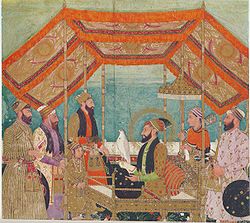
Aurangzeb
Abul Muzaffar Muhy-ud-Din Muhammad Aurangzeb Alamgir , more commonly known as Aurangzeb or by his chosen imperial title Alamgir , was the sixth Mughal Emperor of India, whose reign lasted from 1658 until his death in 1707.Badshah Aurangzeb, having ruled most of the Indian subcontinent for nearly...
(1658-1707) did not actively encourage Mughal paintings, but as this art form had gathered momentum and had a number of patrons, Mughal paintings continued to survive, but the decline had set in. Some sources however note that a few of the best Mughal paintings were made for Aurangzeb, speculating that the painters may have realized that he was about to close the workshops and thus exceeded themselves in his behalf. A brief revival was noticed during the reign of Muhammad Shah
Muhammad Shah
Muhammad Shah also known as Roshan Akhtar, was a Mughal emperor of India between 1719 and 1748. He was son of Khujista Akhtar Jahan Shah, the fourth son of Bahadur Shah I. Ascending the throne at 17 with the help of the Sayyid Brothers, he later got rid of them with the help of Nizam-ul-Mulk Chin...
'Rangeela' (1719-48), but by the time of Shah Alam II
Shah Alam II
Shah Alam II , also known as Ali Gauhar, was a Mughal emperor of India. A son of Alamgir II, he was exiled to Allahabad in December 1759 by Ghazi-ud-Din, who appointed Shah Jahan III as the emperor. Later, he was nominated as the emperor by Ahmad Shah.Shah Alam II was considered the only and...
(1759-1806), the art of Mughal painting had lost its glory. By that time, other schools of Indian painting had developed, including, in the royal courts of the Rajput kingdoms of Rajputana
Rajputana
Rājputāna was the pre-1949 name of the present-day Indian state of Rājasthān, the largest state of the Republic of India in terms of area. George Thomas was the first in 1800 A.D., to term this region as Rajputana...
, Rajput painting
Rajput painting
Rajput painting, also known as Rajasthani Painting, is a style of Indian painting, evolved and flourished during the 18th century in the royal courts of Rajputana, India, flowing from the style of Mughal painting, itself derived from the Persian miniature. Each Rajput kingdom evolved a distinct...
and in the cities ruled by the British East India Company
British East India Company
The East India Company was an early English joint-stock company that was formed initially for pursuing trade with the East Indies, but that ended up trading mainly with the Indian subcontinent and China...
, the Company style
Company style
Company style or Company painting is a term for a hybrid Indo-European style of paintings made in India by Indian artists, many of whom worked for European patrons in the British East India Company or other foreign Companies in the 18th and 19th centuries...
under Western influence.
Mughal style today
Mughal-style miniature paintings are still being created today by a small number of artists in RajasthanRajasthan
Rājasthān the land of Rajasthanis, , is the largest state of the Republic of India by area. It is located in the northwest of India. It encompasses most of the area of the large, inhospitable Great Indian Desert , which has an edge paralleling the Sutlej-Indus river valley along its border with...
concentrated mainly in Jaipur
Jaipur
Jaipur , also popularly known as the Pink City, is the capital and largest city of the Indian state of Rajasthan. Founded on 18 November 1727 by Maharaja Sawai Jai Singh II, the ruler of Amber, the city today has a population of more than 3.1 million....
. Although many of these miniatures are skillful copies of the originals, some artists have produced modern works using classic methods with, at times, remarkable artistic effect.
The skills needed to produce these modern versions of Mughal miniatures are still passed on from generation to generation, although many artisans also employ dozens of workers, often painting under trying working conditions, to produce works sold under the signature of their modern masters. Rafi Uddin is the recipient of a large number of artistic honours from India over the last decades. His younger brother Saif Uddin
Saif Uddin
Saif Uddin is a contemporary Indian artist specializing in ancient and, notably, modern Mughal paintings, Kota school, Jaipur school and Bundi school painting styles as well as custom Indian Jewellery.-Life:...
, who ghost-painted for his famous brother for years, has since become the most recognized modern Mughal painter straying from traditional Indian scenes into more contemporary themes.
Other masters in Rajasthan include Kaluram Panchal, Ram Gopal Vijayvargiya, Ved Pal Sharma, Kailash Raj, Tilak Gitai, Gopal Kamawat, Mohammed Usman and Mohammed Luqman, Kishan Mali Sharma and the Joshi family.
See also
- Persian miniaturePersian miniatureA Persian miniature is a small painting on paper, whether a book illustration or a separate work of art intended to be kept in an album of such works called a muraqqa. The techniques are broadly comparable to the Western and Byzantine traditions of miniatures in illuminated manuscripts...
- Ottoman miniatureOttoman miniatureOttoman Miniature or Turkish miniature was an art form in the Ottoman Empire, which can be linked to the Persian miniature tradition, as well as strong Chinese artistic influences. It was a part of the Ottoman Book Arts together with illumination , calligraphy , marbling paper and bookbinding...
- Indian paintingIndian paintingIndian painting has a very long history, although the seasonally humid Indian climate was difficult for the long-term preservation of paintings and there are far fewer survivals than of other forms of Indian art. The earliest Indian paintings were the rock paintings of pre-historic times, the...
- Tanjore paintingTanjore paintingTanjore painting is an important form of classical South Indian painting native to the town of Thanjavur in Tamil Nadu, India. The art form dates back to about 1600 AD, a period when the Nayakas of Tanjavur encouraged art—chiefly, classical dance and music—as well as literature, both in Telugu...
- Rajput paintingRajput paintingRajput painting, also known as Rajasthani Painting, is a style of Indian painting, evolved and flourished during the 18th century in the royal courts of Rajputana, India, flowing from the style of Mughal painting, itself derived from the Persian miniature. Each Rajput kingdom evolved a distinct...
- Madhubani paintingMadhubani painting]]Madhubani painting or Mithila painting is a style of Indian painting, practiced in the Mithila region of Bihar state, India and the adjoining parts of Terai in Nepal. In the present time the main artists include Smt Bharti Dayal ' Ganga devi ' Smt Bua Devi ,late Smt Jagdamba Devi,late Smt Sita...
- MushfiqMushfiqMushfiq was a sub-imperial Mughal painter who worked in the atelier of Abd-ur-Rahim Khan-i-Khanan , commander-in-chief of the Mughal army in the late 16th/early 17th century. He contributed numerous paintings to the Ramayana and Razmnama manuscripts commissioned by the Khan-i-Khanan...
, a sub-imperial Mughal painter
Further reading
- Painting for the Mughal Emperor (The Art of the Book 1560-1660) by Susan Stronge (ISBN 0-8109-6596-8)
- Fiction in Mughal Miniature Painting by Prof. P. C. Jain and Dr. Daljeet
- Painting the Mughal Experience by Som Prakash Verma, 2005 (ISBN 0-19-566756-5)
- Chitra, Die Tradition der Miniaturmalerei in Rajasthan by K.D. Christof & Renate Haass, 1999 (ISBN 978-3-89754-231-0)

